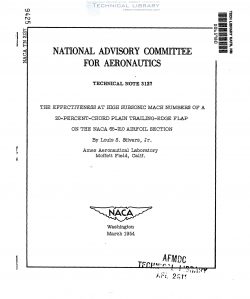naca-tn-3127
- Version
- 122 Downloads
- 640.35 KB File Size
- 1 File Count
- January 20, 2017 Create Date
- January 20, 2017 Last Updated
National Advisory Committee for Aeronautics, Technical Notes - The Effectiveness at High Subsonic Mach Numbers of a 20% Chord Plain Trailing Edge Flap on the NACA 65-210 Airfoil Section

An analysis has been made of the effectiveness of a 20—percent—chord
plain trailing-edge flap on the NASA 65-210 airfoil section from section
lift-coefficient data obtained at Mach numbers from 0.30 to 0.875. The
analysis also includes a comparison of the effectiveness of this flap with
that of a spoiler and a dive—recovery flap on the same airfoil section.
The analysis indicates that the plain trailing-edge flap employed
on the lO—percent-thick airfoil section at Mach numbers as high as 0.875
retains at least 50 percent of the effectiveness exhibited at low Mach
numbers. The plain trailing-edge flap, as compared to the spoiler and
the dive—recovery flap, appears to afford the most favorable character-
istics as a device for controlling lift continuously throughout the range
of mach numbers from 0.30 to 0.875. At mach numbers above those for lift
divergence of the airfoil section, either a plain flap of a dive-recovery
flap is effective in providing auxiliary lift.
Among many effects of compressibility which have been found in flight
and in the wind tunnel is a reduction in the effectiveness of conventional
airplane control surfaces at Mach numbers considerably above the critical
for the airfoil. Extremely large reductions in effectiveness accompany
the use of the control surfaces on relatively thick airfoil sections at
high subsonic Mach numbers. The effectiveness of spoilers and of dive-
recovery flaps on lO-percent—thick airfoil sections has been reported in
references 1 and 2, respectively. The spoilers became decreasingly effec-
tive with increasing projection at high sdbsonic Mach numbers and exhib-
ited characteristics which were such as to promote erratic lift control
for a wide range of Mach numbers. The dive-recovery flaps also showed
generally unfavorable characteristics for use, other than emergency, as
lift-control devices over an extensive range of subsonic Mach numbers.
Wind-tunnel data presented in reference 3 for a plain trailing-edge flap
on a modified NASA 65-series airfoil section 19 percent thick indicated
that the effectiveness of a plain flap on this thick airfoil section
rapidly decreases as the Mach number is increased above the critical Mach
number of the section.
| File | Action |
|---|---|
| naca-tn-3127 The Effectiveness at High Subsonic Mach Numbers of a 20% Chord Plain Trailing Edge Flap on the NACA 65-210.pdf | Download |

Comment On This Post